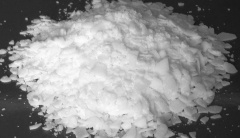Difference between revisions of "Caustic Potash"
(Created page with "{{Infobox_Oils | image = picturefollow.jpg | origin = - | density = - | temperature ...") |
|||
| (8 intermediate revisions by 2 users not shown) | |||
| Line 1: | Line 1: | ||
| − | {{ | + | {{Infobox_Metals |
| − | | image = | + | | image = Caustic_potash-1.jpg |
| origin = - | | origin = - | ||
| − | | | + | | stowage factor = 2,04 m<sup>3</sup>/t (drums) |
| − | |||
| humidity and moisture = - | | humidity and moisture = - | ||
| ventilation = - | | ventilation = - | ||
| − | + | | risk factors = See text | |
| − | | risk factors = | ||
}} | }} | ||
==Description== | ==Description== | ||
| − | + | [[Potassium Hydroxide]] is an inorganic compound with the formula KOH, commonly called caustic potash.<br><br> | |
| − | <br><br> | + | Along with [[Sodium Hydroxide]] (NaOH), this colorless solid is a prototypical strong base. It has many industrial and niche applications. Most applications exploit its reactivity toward [[acids]] and its corrosive nature. In 2005, an estimated 700,000 to 800,000 tonnes were produced. Approximately 100 times more NaOH than KOH is produced annually. KOH is noteworthy as the precursor to most soft and liquid soaps as well as numerous potassium-containing [[chemicals]].<br><br> |
| − | Is toxic by ingestion and inhalation and is corrosive to tissue. On exposure it soon starts to deliquesce due to absorption of water and carbon dioxide from the air. In the majority of cases, it will be found to be slightly discoloured and deliquescing, but in extreme cases, the remaining contents will become a semi-liquid coffee-coloured sludge of no commercial or practical value. | + | Potassium hydroxide can be found in pure form by reacting sodium hydroxide with impure potassium. Potassium hydroxide is usually sold as translucent pellets, which will become tacky in air because KOH is hygroscopic. Consequently, KOH typically contains varying amounts of water (as well as carbonates, see below). Its dissolution in water is strongly exothermic, meaning the process gives off significant heat. Concentrated aqueous solutions are sometimes called potassium lyes. Even at high temperatures, solid KOH does not dehydrate readily.<br><br> |
| − | <br><br> | + | ==Application== |
| − | + | Use: Soap manufacture, bleaching, manufacture of potassium carbonate and tetrapotassium pyrophosphate, electrolyte in alkaline storage batteries and some fuel cells, absorbent for carbon dioxide and hydrogen sulphide, [[dyestuffs]], liquid fertilizers, food additive, herbicides, electroplating, mercerizing, paint removers, reagent.<br><br> | |
| − | <br><br | + | ==Shipment / Storage== |
| − | + | Caustic potash (Potassium Hydroxide) comprises white deliquescent pieces, lumps, pellets or flakes, used in manufacture of soap, dyestuffs, liquid fertilizers, paint removers, etc. Usually shipped in kegs or steel drums.<br><br> | |
| + | Is toxic by ingestion and inhalation and is corrosive to tissue. On exposure it soon starts to deliquesce due to absorption of water and carbon dioxide from the air. In the majority of cases, it will be found to be slightly discoloured and deliquescing, but in extreme cases, the remaining contents will become a semi-liquid coffee-coloured sludge of no commercial or practical value.<br><br> | ||
| + | ==Risk factors== | ||
| + | See the International Maritime Solid Bulk Cargoes Code.<br><br> | ||
| + | See also: http://www.chemicalland21.com/industrialchem/inorganic/KOH.htm<br><br> | ||
| + | |||
| + | [[Category:Products]] | ||
[[Category:Oil and chemicals]] | [[Category:Oil and chemicals]] | ||
| − | |||
Latest revision as of 13:08, 28 October 2013
| Infobox on Caustic Potash | |
|---|---|
| Example of Caustic Potash |  |
| Facts | |
| Origin | - |
| Stowage factor (in m3/t) | 2,04 m3/t (drums) |
| Humidity / moisture | - |
| Ventilation | - |
| Risk factors | See text |
Caustic Potash
Description
Potassium Hydroxide is an inorganic compound with the formula KOH, commonly called caustic potash.
Along with Sodium Hydroxide (NaOH), this colorless solid is a prototypical strong base. It has many industrial and niche applications. Most applications exploit its reactivity toward acids and its corrosive nature. In 2005, an estimated 700,000 to 800,000 tonnes were produced. Approximately 100 times more NaOH than KOH is produced annually. KOH is noteworthy as the precursor to most soft and liquid soaps as well as numerous potassium-containing chemicals.
Potassium hydroxide can be found in pure form by reacting sodium hydroxide with impure potassium. Potassium hydroxide is usually sold as translucent pellets, which will become tacky in air because KOH is hygroscopic. Consequently, KOH typically contains varying amounts of water (as well as carbonates, see below). Its dissolution in water is strongly exothermic, meaning the process gives off significant heat. Concentrated aqueous solutions are sometimes called potassium lyes. Even at high temperatures, solid KOH does not dehydrate readily.
Application
Use: Soap manufacture, bleaching, manufacture of potassium carbonate and tetrapotassium pyrophosphate, electrolyte in alkaline storage batteries and some fuel cells, absorbent for carbon dioxide and hydrogen sulphide, dyestuffs, liquid fertilizers, food additive, herbicides, electroplating, mercerizing, paint removers, reagent.
Shipment / Storage
Caustic potash (Potassium Hydroxide) comprises white deliquescent pieces, lumps, pellets or flakes, used in manufacture of soap, dyestuffs, liquid fertilizers, paint removers, etc. Usually shipped in kegs or steel drums.
Is toxic by ingestion and inhalation and is corrosive to tissue. On exposure it soon starts to deliquesce due to absorption of water and carbon dioxide from the air. In the majority of cases, it will be found to be slightly discoloured and deliquescing, but in extreme cases, the remaining contents will become a semi-liquid coffee-coloured sludge of no commercial or practical value.
Risk factors
See the International Maritime Solid Bulk Cargoes Code.
See also: http://www.chemicalland21.com/industrialchem/inorganic/KOH.htm











